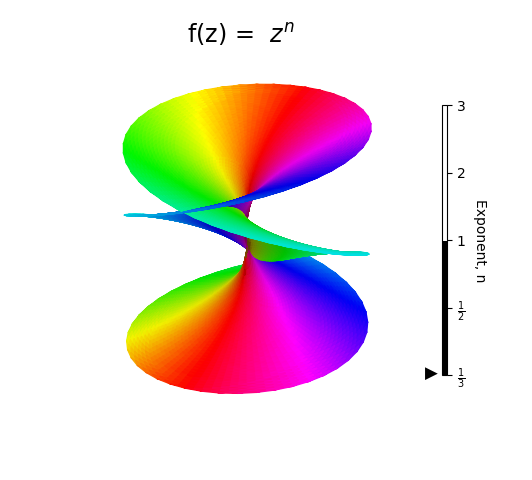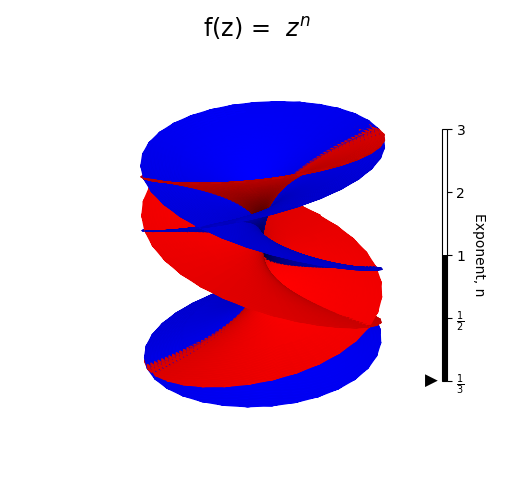Complex Number to a Power¶

Animation control:
Visualization |
Frame Value |
|---|---|
Surface geometry |
functional parameter per frame |
Surface position |
fixed to the coordinate axis |
Surface color |
color per frame |
Shading and highlighting |
fixed to the coordinate axis |
Axis coordinate |
constant |
Based on the static plots from the Parametric Set example.
import numpy as np
import matplotlib.pyplot as plt
from matplotlib.animation import FuncAnimation
import s3dlib.surface as s3d
import s3dlib.cmap_utilities as cmu
# 0. Define animation control parameters ............................
totalTime, f_domain, numFrames = 14, (0.0,1.0), 120 # time in seconds
frames=np.linspace(*f_domain, numFrames, endpoint=False)
interval = int(1000.0*totalTime/numFrames) # milliseconds
# 1. Define functions to examine ....................................
real = True
imaginary = not real
def pover_Z(rtz, isReal, N) :
r,t,z = rtz
A = np.power(r,N)
alpha = N*t if N>1 else t
if isReal : Z = A*np.cos(alpha)
else : Z = A*np.sin(alpha)
return r,alpha/N,Z
elev,azim,lightDir = 20, -150, [1,0,1]
xpont = [0.333, 0.5, 1, 2, 3] # exponents, n
ticPs = [0, 0.25, 0.5, 0.75, 1] # colorbar tick positions
ticLb = [r'$\frac{1}{3}$', r'$\frac{1}{2}$', '1', '2', '3'] # colorbar labels
val = lambda b : s3d.frame_to_value(b,xpont)[0] # linear segment path
frame_to_beta = lambda f : 2*f if f<0.5 else 2*(1-f) # forward to reverse sequence
def indicator_by_A(fig, A, vOld=None) :
# 0 < A < 1
symbol, blank = r'$\blacktriangleright$', r'$\blacksquare$'
horz, vCen, vRng = 0.825, 0.467, 0.26
vert = vCen + vRng*(2*A-1)
if vOld is not None:
fig.text(horz,vOld,blank, ha='right', va='center', fontsize='x-large', color='w')
fig.text(horz,vert,symbol, ha='right', va='center', fontsize='large')
return vert
# 2. Setup and map surfaces .........................................
frame = 0.0
beta = frame_to_beta(frame)
V = val(beta)
rez=5
zMap = cmu.hsv_cmap_gradient( [.5,1,1], [1.5,1,1] )
surface = s3d.PolarSurface(rez, 'squ_c', cmap=zMap)
surface.map_cmap_from_op( lambda rtz : pover_Z(rtz,imaginary,V)[2] )
surface.map_geom_from_op( lambda rtz : pover_Z(rtz,real,V) )
# 3. Construct figure, add surfaces, and plot .....................
rtv = s3d.rtv(lightDir,elev,azim)
minmax = (-1,1)
sm = plt.cm.ScalarMappable(cmap=cmu.binary_cmap('k','w'))
sm.set_array([])
fig = plt.figure(figsize=plt.figaspect(0.9))
ax = plt.axes(projection='3d', aspect='equal')
ax.set_title( r'f(z) = $z^n$', fontsize='xx-large' )
ax.view_init(elev,azim)
ax.set(xlim=minmax, ylim=minmax, zlim=minmax)
cbar = plt.colorbar(sm, ax=ax, shrink=0.6, pad=-.05, aspect=50, ticks=ticPs )
cbar.set_label('Exponent, n', rotation=270, labelpad = 15)
cbar.ax.set_yticklabels(ticLb)
ax.set_axis_off()
ax.add_collection3d(surface.shade(0,rtv))
prevIndicator = indicator_by_A(fig, beta)
fig.tight_layout()
#plt.show()
# 4. Animation ======================================================
def update_fig(frame):
global surface
global prevIndicator
surface.remove()
beta = frame_to_beta(frame)
V = val(beta)
surface = s3d.PolarSurface(rez, 'squ_c', cmap=zMap)
surface.map_cmap_from_op( lambda rtz : pover_Z(rtz,imaginary,V)[2] )
surface.map_geom_from_op( lambda rtz : pover_Z(rtz,real,V) )
surface.shade(0,rtv)
prevIndicator = indicator_by_A(fig, beta, prevIndicator)
ax.add_collection3d(surface)
return
anim = FuncAnimation(fig, update_fig, frames, interval=interval, repeat=True)
anim.save('complex.html',writer='html')
msg = "saved {} frames, values: [{:.3f} to {:.3f}] @ {} milliseconds/frane"
print(msg.format(numFrames,np.min(frames),np.max(frames),interval))
In the above animation, the real and imaginary components are respresented by geometry and color, respectively. Changeing the highlighted lines in the above script by:
surface_I = s3d.PolarSurface(5,'hex_c', facecolor='red')
surface_I.map_geom_from_op( lambda rtz : pover_Z(rtz,imaginary,V) )
surface_R = s3d.PolarSurface(5,'hex_c', facecolor='blue')
surface_R.map_geom_from_op( lambda rtz : pover_Z(rtz,real,V) )
surface = surface_I + surface_R
both real and imaginary componets are represented as blue and red surfaces, as shown below:

